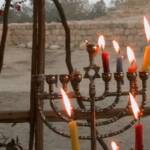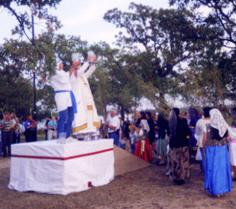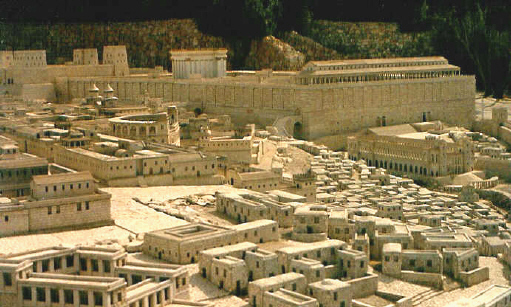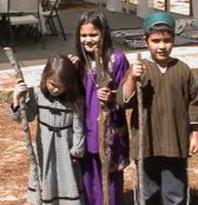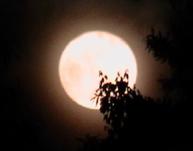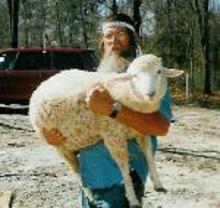(Citas con nuestro creador)
Appointments
with our
Creator
If you were invited to an appointment with the Creator Himself, you would consider it very important, wouldn't you? You would make every effort to be on schedule and not miss a detail of how He wanted you to dress and act. But the truth is, you have been invited to not just one, but many appointments with Him! Yet most people who say they love Him are missing every one of them.
Today we are used to the Roman calendar and its holidays. But our Creator, YHWH, set up a different calendar long before ours existed. He built into it repeating themes so that the same type of thing occurred several times on the same date. For example, both Solomon's and Herod's Temples were destroyed on the same day of the year, the ninth of Av.
On a gladder note, Noah's ark came to rest on the very same day of the year that the waters of the Red Sea buried Pharaoh's army, and the same date on which Haman was exposed and condemned in Queen Esther's time. They all picture deliverance.
At Mt. Sinai, YHWH commanded Israel to appear before Him at certain "appointed times" (Hebrew, mo'edim) on which there were to be "holy convocations" which also have the sense of "rehearsals" of great events that would happen later in history on those very days on His calendar. YHWH would in some way meet with Israel in a special way on these days.
He gave these festivals in two sets. The first set falls in the spring:
SPRING FESTIVALS:
YHWH told Israel that the month during which Passover fell was to be the first month on our calendar. The Feast of Unleavened Bread then begins at sundown and lasts seven days (in case you were wondering why the background of this page looked like a saltine cracker).
The day after the Sabbath that follows Passover is called the Firstfruits of the Barley Harvest. But how can we know that the barley will be ready by that time every year? It is important that the set times given by YHWH line up with the agricultural cycle. With months actually based on the moon, they do not always line up with the lunar cycle, as we see on the Islamic calendar in which the months, e.g., Ramadan, actually move around to different times of the year.
But YHWH planned for that. The description of the first month ("Aviv") gives us the clue. The year begins at the the new moon when the barley crop has reached a stage of ripening called aviv. At creation (Gen. 1:14) YHWH had said the sun, moon, and stars were created for signs and "appointed times", this same Hebrew term for the festivals. So we must watch the signs He gave in the heavens to know when the festival seasons begin. And studying YHWH's patterns in agriculture teaches us about bearing spiritual fruit as well. Once these two signs converge, Passover will fall at the next full moon, the 14th of the month also called Aviv.
Firstfruits of the Barley Harvest begins a countdown of seven weeks, culminating in the "Feast of Weeks" (Shavuoth), when the wheat crop would begin to be ready. After a long gap in the calendar, which gave everyone time to grow the rest of their crops, there is a second cluster of Festivals:
FALL FESTIVALS:
The fall festivals all come in one cluster within three weeks of one another. Yom T'ruah (often called Rosh haShanah) is a day to be awakened to the fact that Yom haKippurim (often shortened to Yom Kippur), the Day of Atonement, is only nine days away, so that one may remember to repent in preparation for the "high holy days" if he has not already been doing so. (The entire month prior to this is dedicated to repentance, or T'shuvah, but the last ten days are especially intense. Sukkoth then follows only five days later, a time to built and dwell in temporary shelters to recall the time we lived in the Wilderness under Moses and to recall that it is YHWH who is our true protection all the time. It is also a celebration of the harvest He has brought and, by tradition, a time to pray for the rain we need for the next growing season.
If you are coming from a New Testament framework, even there these festivals are counted as part of the "milk"--the most basic teachings we must understand before we can get to the "meat"--the deeper teachings of Scripture. (1 Cor. 3:2) Paul told non-Jewish believers to celebrate Passover (1 Cor. 5:8), so we can't say they are just for the Jews. Yet most are busy with a whole different festival calendar that is actually based on the dates of pagan feasts, and many of the customs they included were also carried over into the modern celebrations, even though most people have forgotten where they came from.
Adding non-prescribed commemorations is not in itself sinful, for Purim is endorsed by the Book of Esther, and the Messiah participated in Hanukkah (the Feast of Dedication, John 10). But YHWH wasn't pleased when Jeroboam changed the time in which the festivals were observed, because there was paganism involved in that, and the same holds true for the pseudo-biblical Christian holidays.
Most Christians realize that Yeshua was not really born in December, but haven't known what to replace the pagan commemoration with. But with so many Jews now also believing in him, an answer has come to light. David's schedule for priestly service (1 Chron. 24) clues us in on the time of year John the Baptist's father was serving in the Temple and was told he would have a son.(Luke 1:5) From there we can calculate Yeshua's birth, six months after John (Yochanan)--and the simple bottom line is that it comes out at Sukkoth. It was one of the three pilgrimage festivals when every able-bodied male is required to come to Jerusalem. The city was barely more than a square mile, so many would spill over into the suburbs, including Bethlehem, only five miles away. This explains why there was no room in the inn; Joseph would combine the trip to Bethlehem for the census with his necessary journey for the festival.
Sukkoth also means "stables" in Hebrew (as used in Gen. 33:17). It's fitting that the "Word became flesh and lived temporarily among us" (John 1:14) right during this feast of dwelling in temporary structures. A sukkah (singular) is traditionally to have gaps in the roof big enough to see stars through--correlating with the "star of Bethlehem". Shepherds would not have sheep out in their fields during December, but would still have them there during Sukkoth, just after the harvest. The angel told them he had glad news of great joy. Sukkoth is nicknamed "the season of our joy", and emphasizes the inclusion of all peoples.
So there's no need for a half-biblical, half-pagan Christmas. If we need a time to celebrate his birth, we already have a pure, prescribed festival at that time. Why not stick with what's trustworthy and sure?
It was on the final day of Sukkoth, during a special ceremony in which water was poured over the Temple altar, that Yeshua offered living water to any who were thirsty. (John 7)
Clearly everything he said and did was set by this calendar. His crucifixion was on Passover. On the day after the Sabbath following Passover, Yeshua was resurrected. Paul even calls him the "firstfruits of those who slept" (I Cor. 15:20), because the day of firstfruits was when he came out of the ground. Dying on the 14th of Aviv, he was in the grave for three days and three nights, that day had to be the 17th of Aviv, the day Yahweh had accomplished those other momentous examples of deliverance mentioned above.
These feasts put everything we've known about him back into its original context, and make more sense out of so much of what he said. Constantine removed them from the church, effectively creating the "Dark Ages" since nothing made sense anymore. But in His mercy YHWH is restoring them in these last days. During the Kingdom, all nations will be required to at least send representatives to Jerusalem for Sukkoth or forfeit that year's rains. (Zech. 14)
We mustn't overlook the first of YHWH's appointments with us: the Sabbath, established all the way back at creation as a way to share in Yahweh's rest. How can people who live for the weekend view a day when no one is ALLOWED to work as legalism?!
The Sabbath and the Festivals were given as a "statute forever". (Ex. 31:13; Lev. 23) Certain gates in the Temple were only open on the Sabbath and Festivals. This tells us that these are times when a special doorway is opened to the heavenlies that will enable us to know Him in an unusually unobstructed way.
These appointments are a hands-on way YHWH offers to learn many things He wants us to know about Himself. What more reason do we need?
Confirmed
Calendar Dates
Aviv barley was found in Israel on 3/17/2025.
The new moon was sighted in Israel by 6 or more witnesses on 6/26/2025, beginning the 4th Biblical month. (Exodus 12:2)
Look for the next new moon report on or around 7/26/2025.
(The Tzadoqite/Essene 4th "month" began 6/25/25.) See more about this ancient alternate calendar below.
Now maintained at newer website
14th of First Month
(Aviv--when
green ears of barley appear)
15th-21st
of Aviv
(First month)
Day after the Sabbath following Passover
7 weeks later
on the first day
of the week
1st day of 7th month
(Ethanim or reliable, steadily-flowing streams)
10th of Ethanim
15th-21st of Ethanim
Passover
(Pesakh)
(Matzah)
Firstfruits
of the Barley Harvest
(Begin "Counting
("Weeks")
("Day of the Awakening Blast/Shout")
a.k.a. "Rosh haShanah"
(civil new year)
(Day of Coverings)
(Temporary
Dwellings)
- Lamb chosen on 10th
- Inspected-
- House cleansed of leaven
- Blood on doorposts
- Firstborn spared
- Eat no leaven
- Do eat unleavened bread
- Give Yahweh the best of what we produce
- Preparing for maturity
- Giving of Torah at Sinai
- Firstfruits of the Wheat Harvest
- Leavened loaves
- Offered to all nations
- 3,000 fell in one day
- First judgment
- Gates open for undecided to repent
- "Last trumpet"
- "No one knows the hour or day" (on a new moon)
- "Great trumpet"
- Fasting, confession
- Gates closed
- Temporary dwellings
- Living water
- "Light of the World"
- "Season of our Joy"
- All nations included
- Triumphal Entry
- Cross-examination
- Cleansing the Temple
- Y'shua's death
- Covenant renewed
- Dead to sin, but
alive to Yahweh
- Messiah becomes "firstfruits of those who have fallen asleep"
- Completing his body
- Firstfruits of the
Northern Kingdom
- Harvest from nations
- 3,000 brought back
on the same day
- Resurrection of the righteous
- Final warnings on earth
- Messiah's wedding and coronation
- Wicked judged
- Earth cleansed
- "Feast of Leviathan"
- Messiah's birth
- Restoration of all things
- Peaceable Kingdom
- Sabbath for the earth
Calendar Name of Feast Components/ New Testament Prophetic
Dates (Appointment) Themes References Fulfillment
YHWH's Calendar
John 1:29
Mark 11:15-18
Mark 11:27-33
2 Tim. 2:20-21
1 Peter 1:18-20
1 Cor. 5:6-8
Luke 22:7
Luke 12:1
Romans 6:11
1 Cor. 15:20-23
Ephesians 4:4-25
Acts 2
Romans 8:23
Matthew 25:1-13
1 Cor. 15:52
1 Thess. 4:16-17
Matt. 24:31
Matt. 25:14-46
John 1:14
John 7:37
Luke 2:10-14
The Month Begins in Yerushalayim (Jerusalem)
by R. Webster
The calendar (predetermined through calculations) set up centuries ago by Jews
in forced exile has served a valuable purpose over the centuries, because it was
the closest we could come to YHWH's intended appointments in an age of poor communications among scattered exiles from the Land. But now that there are
those back in the Land of Israel able to announce sightings of the New Moon
there, we do not believe substitutes are needed any longer. We receive these via Internet and we forward them to anyone who wants to receive them. (Subscribe to our news group in order to receive these announcements.)
We reckon the new moons ON THE NEXT LOCAL EVENINGS after the moon is spotted in Yerushalayim. We reckon the Moedim (Festivals) ON THE NEXT LOCAL EVENINGS after they begin in Yerushalayim, and we reckon the Shabbats ON THE NEXT LOCAL EVENINGS after they begin in Yerushalayim.
We do not consider it Rosh Chodesh (the beginning of the month) locally the very minute the New Moon is spotted in Yerushalayim, but rather when the yom next arrives in our part of the world. (Yom roughly = "day" in English and consists of erev [evening] and boqer [morning]; see Gen 1:5.)
Everything--the New Moons, the Shabbats, and the Moedim [appointed times]--begin in Yerushalayim and emanate out into the rest of the world, arriving with the mixing of light and darkness, called erev in Hebrew and "dusk" in English. This makes Yerushalayim the reference for all observances.
Yerushalayim is called "The City of the Great Elohim", "The Throne of YHWH", "The Set-Apart Mountain", "The Perfection of Beauty", "The Joy of the whole Earth".
Zech 8:3
"Thus says YHWH: `I will return to Zion, and dwell in the midst of Jerusalem. Jerusalem shall be called the City of Truth (emeth), the Mountain of YHWH Tzava'ot, the Holy Mountain.'
Emeth [according to Strong's Concordance #571] means "firmness, faithfulness, truth, sureness, reliability, stability, continuance, faithfulness, or reliability". Emeth [according to Strong's Concordance #571] means "firmness, faithfulness, truth, sureness, reliability, stability, continuance, faithfulness, or reliability".
Only Yerushalayim is the City of faithfulness, reliability, and true doctrine. From where, but from the City of Truth, the Throne of YHWH Tzava'ot, would a day emanate? What other place can be considered as reliable?
Other special days...
There is no way to have more than a surface understanding of the events in Scripture without a working familiarity with the Hebrew calendar. It forms the backdrop for all the festivals and appointed times. The reason we need a calendar at all is because of three factors, which at present do not precisely line up with one another:
(1) The orbit of the moon around the earth (a month), which at present takes about 29.5 days.
(2) The rotation of the earth on its axis (a day), which takes about 24 hours.
(3) The revolution of the earth around the sun (a year), which requires about 365.24 days.
Most of us are more used to thinking in terms of the Gregorian calendar (a revision of the Julian calendar of Rome made official by Pope Gregory XIII). This calendar has two segments, traditionally labeled B.C. ("before Christ", which counts down to Yeshua's birth) and A.D. (anno domini, or "the year of our master", which counts upward since his birth, though the count is off by a few years). While most nations have adopted the same calendar, many, especially those who do not wish to recognize any authority of the Roman Catholic Church to name the era, use the terms C.E. ("Common Era") for the present era and B.C.E. ("Before Common Era", the equivalent of B.C. in numbering).
The Jewish calendar, in contrast, starts with creation, and the current date is derived by adding up the ages of people mentioned in Scripture and historical records since that time. For example, the Jewish year that overlaps with both 2022 and 2023 C.E. is numbered 5783.
This also shows that the year does not begin at the same time on both calendars. The Jewish year begins not on January 1, but on Rosh haShanah ("head of the year", but called Yom Teruah in Scripture), which falls on a new moon in the early autumn. That is when the numbered year changes. This follows the anniversary of Creation and the calendar that was in effect for the whole world until the time of the Exodus, and continued to be the "civil calendar" for Israel thereafter as well, much as many organizations have a "fiscal year" which begins halfway between January 1 and December 31 or even at other times.
But there is another calendar in Scripture which was given exclusively to Israel. YHWH declared that the month in which He brought Israel out of Egypt would now be the first month for us. (Shemoth/Exodus 12:2) This is six months after Yom Teruah, so that Yom Teruah begins the seventh month on the Hebrew calendar while it remains the first new moon on the civil calendar.
Both calendars continue to be used throughout Scripture. They run simultaneously. We have to look at contextual clues to determine which is being referred to in each particular case. While we use the Gregorian calendar with the world at large, and may have to initially translate from one to the other while we make the transition, we want to get to the point where, for example, if someone says, "When is Hanukkah this year?", the only answer that comes to mind is "On the 25th day of the 9th month, of course! That's when it always starts!"
The reason it "moves around" the Gregorian calendar is because a year is now never exactly twelve months long, and both calendars deal with this in different ways. The Gregorian calendar adds a day every "leap year", for example. The Jewish calendar adds a whole month every few years instead to keep the solar and lunar calendars aligned.
The way dates were determined in Biblical times was according to two major factors:
(1) The sighting of the new moon, which defines a new month. (Witnesses would go before the Sanhedrin and answer questions to determine if what they had seen fit the characteristics of a new moon.) The month begins when the moon is sighted in Israel, not the international date line or wherever in the world it might be first sighted, because "the Torah shall go forth from Tzion." (Mikha 4:2) It then continues westward as the sun sets in each time zone.
(2) The Aviv (which is when ripening barley reaches a stage at which firstfruits can be harvested in two weeks--see photo at right), which determines the first month of the year, in which Passover and this firstfruits offering must occur. Because the Aviv is not always reached by the end of the twelfth month, a thirteenth month must sometimes be added in order to keep the festivals aligned with the proper seasons of the year. The blooming of the almond tree is also noted in Scripture as a sign that the new year is about to begin--a reminder to watch for the Aviv.
The present-day Jewish calendar was developed out of necessity in the 4th century C.E. by Hillel II after there was no longer a large Jewish presence in the Land of Israel and even if someone was there to sight the new moon, it could not be communicated quickly enough to exiles in every location around the world, especially on days such as Rosh haShanah (Yom Teruah), when the festival begins right on the new moon. So a calculated calendar was devised which standardized the dates for many years to come. It determined that within a cycle of 19 years, a thirteenth month is added during the third, sixth, eighth, eleventh, fourteenth, seventeenth, and nineteenth years.
The extra month is added between the eleventh and twelfth months (fifth and sixth on the civil calendar), and called Adar I, while the month simply called Adar in other years is called Adar II. Thus Purim (the 14th day of the twelfth month) is celebrated in the final month of any year rather than the twelfth as such.
During the diaspora (dispersion), this calendar was of great help, but it is no longer necessary because of both the possibility of spotting the new moon in Israel and instant communication such as via telephone or the internet.
While the contrived calendar has been amazingly accurate for having been set so many centuries ago, it still occasionally does not line up with the Aviv and often sets the new moon a day or two off from the actual sighting. Therefore, some, like ourselves, have returned to the ancient method of observing the holidays based on the actual new moon sighting and the Aviv. A thirteenth month is simply added whenever the Aviv stage of barley has not been reached by the end of the twelfth month. Since we do not know until a few days beforehand whether there will be a thirteenth month, should Purim be celebrated in the actual twelfth month every year? Not necessarily; it is not a commanded festival, and the book of Esther says it is for the Jews and any who wish to celebrate with them, so we feel that the date in this case should be determined by the Jewish calendar. The same goes for Hanukkah, which is a specifically-Jewish festival.
But otherwise, we must sometimes distinguish between the Biblical calendar and the Jewish calendar as used today, though the new Sanhedrin in Jerusalem has on its agenda a discussion of the return to the sighting of the new moon as the defining factor for the calendar. Of course this makes dates much less predictable, but the Hebrew way is to be ready to pull up stakes every time the Ark of the Covenant and the cloud of Yahweh's presence move.
Another way of calculating the calendar has been found among the Dead Sea Scrolls related to the books of Jubilees and 1 Enoch, and some are beginning to follow this "old calendar" that the Essenes and residents of the Qumran community kept, considering the Sanhedrin's calendar too influenced by Babylonian paganism. It is based on renewals not of the moon, but of the four seasons as well as the weekly sabbath, for it always comes out in an exact multiple of 7. Months, however, do still have 30 days (as seen throughout Scripture) as a reminder that at one time there apparently were exactly 12 months in the year, and all of these adjustments, needed after a shift in both the poles and the earth's orbit in 701 BCE, were not yet necessary. The fact that the book of Revelation equates 1,260 days with 42 months suggests that during the Kingdom, called the "time of the restoration of all things", something huge will put the earth back on its original course, the years will again be 360 days (where else did a 360-degree circle come from?) and months again exactly 30, removing all the present-day difficulties in calculating exactly when the feasts are to be kept. May YHWH speed that day!
The two types of holy days prescribed in Scripture are the hag (which means "to move or dance in a circle") and the moed ("appointed time" or "appointment", based on the word for "to bear witness" since it bears witness to us of who YHWH is and makes us part of the witness as we participate). Hagim are a subset of the moadim.
Hag gives us a clue that we should not think of time as a straight line, but as an upward spiral that keeps passing the same points as it heads back toward the Garden of Eden--a level higher and a step closer each time if we stay on track!
Reflections on the Tzadoqite Calendar
As if there were not already enough controversy among returning Israelites about the calendar, in recent years another ancient theory of how it is to be ordered has come to light, largely through the Dead Sea Scroll discovery in 1947 and the subsequent release of the manuscripts to the public, largely through the work of Dr. Robert Eisenmann and the late Dr. Hershel Shanks. One of the books most commonly found among the scrolls is the book of Yovelim (Jubilees). It was very influential in setting the customs practiced among the Qumran sect, which is often thought to be composed of Tzadoqite (Zadokite) priests who left the Temple compound because they found the corruption there caused by Hellenization to be insufferable. They started their own community where they could practice the Torah, especially the purity laws, in the way they understood to be more correct.
Yovelim purports to be a message from an angel given to Moshe on Mt. Sinai. This is a book that has been in some canons throughout history, but is not in the currently-most prevalent ones. If it is valid, we have in it much more information about when some things mentioned in passing in Scripture took place, such as the claim that Adam and Chawwah (Eve) lived in the Garden of Eden for seven years before they disobeyed. Or how the land where Melchitzedeq lived came into the hands of the Canaanites. Or how many years there were between events described in Scripture.
But early on in the book there is a detailed description of how the Israelite calendar is to be calculated, and it is very different from that which has been practiced among Jews throughout the millennia.
Based on positive events on particular new moons during the flood of Noakh, it claims, “Noakh ordained them for himself as feasts for the generations forever” and they were “placed on the heavenly tablets.” (Jubilees 6:23-29) Each of these days was to be considered the beginning of a new season, and was placed between groupings of 3 30-day months. However, the angel allegedly told Moshe that if Israel did not follow this 364-day reckoning of the year, “they will disturb all their seasons and the ears will be dislodged from this order”. Specifically, “there will be those who will assuredly make observations of the moon, how it…comes in from year to year ten days too soon. For this reason the time will come when they will…make an abominable day the day of testimony and an unclean day a feast day, and they will confuse all the days, the holy with the unclean.” (Jubilees 6:33, 36-37) In other words, they would end up eating on the true Yom Kippur and fasting on a day that means nothing to YHWH, etc.
The Book of I Hanokh (Enoch), an apocalyptic work also popular in the time of the Qumran sect and purported to have been written by the pre-Noakh patriarch by that name, in chapters 72 through 74, agrees with the 364-day count, but states in detail the obvious problem: that “the moon has 30 days less than the sun and stars”. (73:12) A system of intercalary months was added some years so that the lunar and solar years could line up.
Contemporary writings like those of Josephus and the Mishnah tell us that during Second Temple times, the sighting of the new moon by reliable witnesses in Jerusalem was communicated across distance (the whole land of Judea and Galilee and all the way to Babylon, where a huge contingent of Jews still remained) by “smoke signals”—fires built on mountaintops that could be seen from one to another and then relayed.
But some hostile Samaritans interfered by lighting fires at the wrong times so the Jews would celebrate on the wrong day. Therefore a calculated calendar was devised, which could be communicated in advance and does not require the sighting of the moon and its communication over long distances. Though created almost two millennia ago, it still usually comes within 2 days of the actual new moon. But now that we have instant communication via internet, there is increasingly a push to get back to the old way of setting the calendar by actual sightings. The complicating factor is just not knowing in advance the exact days one needs to ask off from work, for example.
The difference between these two views has already caused enough controversy in Hebraic circles. Most Jews, including Messianic, follow the precalculated calendar. The Karaites (successors to the Sadducees/ Tzadduqim—whose name also suggests a connection to the wider group of Tzadoqites, but Avot of Rabbi Nathan says they were followers of a different and later Tzadoq—rather than the Pharisees, the philosophical “ancestors” of modern rabbinic Judaism) follow only Torah and not Talmudic traditions, and they look for the sighting of the moon rather than the predetermined calendar. (The first month is determined by the barley being at the aviv stage, based on the etymology of that term as used in Scripture.) Many newcomers to Torah from among non-Jews have opted for this path.
The Way this Calendar Differs
The Tzadoqite calendar’s proponents, however, since earliest times, have insisted that theirs is the only right way, saying that all other calendars are based on pagan influences or compromise with the Greeks as a tradeoff for political freedom.* This kind of dogmatism based on something extra-Scriptural does raise red flags. On the other hand, if it is indeed a more ancient way, it certainly deserves an honest investigation. So, like many more prominent leaders in Hebraic-Roots circles, I have tried to give it a fair objective look.
It is based on a solar, not lunar, calendar: “The East Gate into the temple used to be called the Sun Gate or Sunrise Gate. The Sun Gate was used to record the vernal and autumnal equinoxes. Before the exile into Babylon it was held to be of imperative necessity that on two days of the year the sun shone directly through the Eastern Gate and through all the Eastern Gates of the Temple arranged in a line, directly into the very heart of the Temple proper. The …Sun Gate served not only to check the equinoxes, when the sun rises exactly in the east, but the solstices as well: a device on the Eastern Gate was designed to reflect the first rays of the sun on the summer and winter solstices, when the sun rises in the southeast and the northeast respectively.” [Worlds in Collision by Immanuel Velikovsky—incidentally an author whose major premise I accept.]
The Qumran community “conceived part of its duty to be the continuation of the functions assigned in the Torah to the Zadokite priesthood.” (Encyclopedia.com) Tzadoq/Zadok (meaning “Righteous”) was a high priest descended from Aharon, Eleazar, and Pin’has. He aided and stayed true to King David during the revolt of his son Absalom, and assisted David in his official role to confirm King Solomon’s accession to the throne, and possibly also remained loyal to the house of David when the northern ten tribes seceded. Because they were faithful when other priests were not, his descendants are given a special blessing in Ezekiel 44:15ff. So any ruling that is in fact traceable to them would be especially authoritative.
The Qumran community’s internal claim is that their leaders were Tzadoqite priests. However, since the community was not very large (I have seen its ruins four times) they are likely to have been Essenes who seceded from the larger body of Tzadoqite priests, and not necessarily reflected he views of the majority.
This community accepted Jubilees and I Enoch as canonical Scripture, or at least as authoritative for their rules. These led them to accept the 365-day calendar, which consists of four sets of three equal-length “months” interspersed each time by one additional day which was either an equinox or solstice. The “months”, however, actually had nothing to do with the moon’s cycles or sighting, but were simply counts of 30 days. The argument is that khodesh, the Hebrew term usually considered to mean “new moon” simply means “renewal”, and has no denotation of the moon per se; the moon is yareaH in Hebrew, or occasionally levanah. The text that allows the moon to be disregarded is Genesis 1:14, which says, —"Let there be lights in the firmament of the heaven to divide the day from the night; and let them be for signs, and for seasons, and for days and years”; “months”, they say, is conspicuous by its absence. The moon, therefore, is not central, and, what’s more, the lunar calendar was imported from Babylon; Scripture’s calendar, they say, is primarily solar instead.
The Tzadoqite view does solve the problem of prediction by simply doing away with moon sightings at all and just counting the months as 30 days, regardless of the stage of the moon, adding up to 360 days. With the intercalation of only those single days between the seasons—4 during the year—they only have to add one week every 7 years to line up with the actual 365 rather than 364 days.
But an important question is whether the 364-day calendar really goes back as far as Moshe or Enoch. Do we have other evidence that could prove or disprove these claims?
Not much detail is given in the Torah itself about how to calculate months and years. Could it be that at the time it was given on Mt. Sinai, the commands may have seemed more self-explanatory because things were not so complicated? If so, what brought about complications later? Have the lunar and solar cycles always been out of synch?
Scientific findings
There is now evidence (not explicitly stated in Scripture but not contradicted by it) that prior to 701 B.C.E. (when Hizqiyahu/Hezekiah was king in Jerusalem, long before Qumran but well after Sinai and much longer after Enoch), all the calendars around the world had 360 days—the reason there are 360 degrees in a circle—a rather arbitrary choice otherwise. The lunar month was actually 30 days long, and there were exactly twelve months in a year—a very neat order which would seem to fit with YHWH’s orderly creation, and simple to follow. No need for explanation. Hence, the lack of detail in the Torah. It may have been self-evident at that time.
After 701 B.C.E., however—the year time went backward several hours on Akhaz’s sundial (Isaiah 38:8)—all the nations on earth scrambled to come up with a way to align the months with the now-longer years.** Why?
A group of physicists and astronomers named Patten, Hatch, and Steinhauer*** found the change to have been caused by the repelling of the electromagnetic poles of earth and Mars, which used to have an orbit that crossed the earth’s and would come very close to us every 54 years. Now the year was no longer 360 days, but longer. They had to first figure out by how much, and then make adjustments. One nation added days this way, another that. We have leap years and varying-length months which bear no resemblance to the dates of the actual new moons. Islam simply kept lunar 12 months and a shorter year, so their festivals (most obvious in the month of Ramadan) migrate around the seasons from year to year. Israel added a whole extra month 6 out of every 19 years to keep the agriculturally-related festivals in the right seasons, though this may not have been the original solution.
Scriptural Critique
What does Scripture say to the claims of the Tzadoqite calendar?
The first area of concern is that there is no command in Scripture to watch for the spring equinox—or any solar stage, for that matter; the closest we can come is a not-very-clear allusion to the sun’s course across the sky in Psalm 19.
The Babylonians did make the moon central (as the Arabs also do), but it was the solstices and equinoxes that the Druids and other European pagans were preoccupied with, so one is not necessarily less holy than the other. Ezekiel condemned Israelites for sun-worship as well. (8:16) So neither the sun nor moon would seem to take precedence, except that the sun is called the “greater (larger) light” in the creation account. Torah is clear that neither is to be worshipped, but both are instrumental in the reckoning of signs and seasons.
The beginning of the year since the time of the Exodus (long before 701 B.C.E.) has been the “month (or renewing) of the Aviv” (Exodus 12;2; 13:4) and, indirectly, the almond tree’s flowering, since in Hebrew the word for “almond” is “the one watched for”. (see Jer. 1:11ff) It flowers first, and is a signal to start watching the barley to see when it is in the aviv stage, as the next new moon may begin the new year. Though the intercalation began after this, the command would not need to change, for Aviv is not actually the name of the month, but the description of the time of year in which that particular new moon falls. The extra month, when added, comes just before this month if the aviv barley is not yet ready, in sighting-based calendars. (In the pre-calculated calendar, Purim is shifted to this “second” twelfth month.)
Khodesh does primarily mean "renewing" (such as in the “renewed covenant”), but in the calendar context, a renewing of what, if it doesn't line up with something every common observer, not just mathematicians, could clearly identify? If a month starts on a different day of the moon’s cycle each time around, what is the sign we could see in the sky? And how is that any better than our Gregorian months which don’t align with the moon cycles?
According to Genesis 1:14, the moon exists to be a sign. If the renewal of the visible moon isn't the sign, what stage of the moon would be a sign? In Psalm 89:37, the moon is called a "faithful witness". How would it be a witness if its appearance was several days into the cycle? (Interestingly, Yeshua is called a "faithful witness" in Rev. 1:5--maybe because he reflects YHWH as the moon reflects the sun? Heb. 1:3) Passover (and probably referring to Sukkot too) is supposed to be on the full moon (keseh) according to Psalm 81:3. (Admittedly this one is not extremely clear, having been interpreted several different ways.) If the month starts on a day other than the visible new moon, how would those two festivals always be on the full moon?
1 Kings 8:2 does parallel yareaH (moon) with khodesh in the same sentence. This refutes the idea that khodesh has nothing to do with the moon. While the word khodesh does not directly mean “month”, but “renewal”, there is a word derived from yareaH—yeraH, which denotes a lunar cycle (2 Kings 15:13, Zech. 11:8, etc.)—what we would typically call a “month” today (a word also based on “moon”)--and it is used of the months otherwise described by khodesh (e.g., Ziv, the 2nd month, as in 1 Kings 6:37, and Bul, 1 Kings 6:38—long before the Babylonian captivity, so these are probably Hebrew names from around 1000 BCE, as these are the only places in Scripture that these month-names are used). In fact, the “month” (yeraH) in the latter case is defined in Scripture as “the 8th khodesh”. Khodesh is used of Ziv in verse 1 of the same chapter. It may or may not be referring directly to the new moon of that month, though it is likely since it would give the exact date Solomon started building the Temple, an event for which such precision would be appropriate. The exact same pattern is present in 1 Kings 8:2, cited above. So the terms appear to have sometimes (as in 6:38) been used interchangeably. After all, what else in the heavens renews every 30 days? Again, why is it called a “renewing” otherwise? A renewing of what?
What may be the strongest argument for the term khodesh being able to include full lunar cycle is that in Exodus 13:4 Israel is told, “Today you are going out, in the khodesh of the Aviv.” Our ancestors did not leave on the new moon (the first of the month, the literal day of renewing) but on the 15th of the month, well into the cycle, but still within that “month”. This would not have been true if khodesh could only refer to the beginning of the month, not the whole month.
Since the yareaH is called a “witness” in Psalm 89:37, it would seem to have to be something visible that would be indisputable, empirically.) YeraH may be the earlier term, used of the enumeration of days in the year, when counted by months. (Job 3:6; 39:2) YeraH is used when describing the part of the month when the moon “withdraws” in the same way the sun “disappears” when it sets, setting the stage for the next renewal. (Isaiah 60:20) So it is clearly referring to the whole cycle of the moon, while khodesh speaks in particular of when the cycle begins, as the moon appears.
Proponents of the Essene calendar claim that the phases of the moon should be disregarded in setting the calendar because “months” are not mentioned in Genesis 1:14 as one of the things the sun, moon, and stars were created to mark. But in Psalm 104:19, the word yareaH is linked with moedim, the same term used in that verse: “He made the moon for appointed times”. And all the days we are to set apart (other than the weekly Sabbath) are defined by which month they are in and how far into the month they are. So the moon is needed for that.
That seems to be about as specific as Scripture gets++, though Nazarene rabbi James Trimm has raised the question, if they are indeed authoritatively Tzadoqite, “Why pick and choose the calendar alone from the Qumran sect? Why not follow all of its rules?” but proceeds to show how some of them contradict Yeshua’s own teachings, not to mention being arguably cruel.
Other Considerations
Just because the Qumran sect had a preference for the book of Jubilees does not guarantee that it was Scripture (for they had other writings like the Damascus Document and Community Rule), though it could be a strong argument for it. It was included in the Ethiopian Canon but rejected by others for various reasons. But no complete copies of it or Enoch are available in the original language, and they are thought to not be actually written by the claimed authors, but pseudepigraphal works traceable only to about 200 B.C.E. Both appear to be polemical in nature—that is, written to appear to be an authoritative answer in controversies that arose later (including this calendrical one which would not have been necessary until well after Moshe), rather than bearing the marks of simple holy revelation.
That both use the 364-day system confirms to me that they were written after 701 BC, which may mean they have a lot of valuable information, possibly some of it passed down since Enoch (as that book does contain the sentence which Jude quotes) and other early record-keepers, but that at least some parts were added later rather than all being from Enoch's own day. Enoch lived before the flood, which was before there were seasons (as we think of them) on earth. (Gen. 8:22) There was probably a vapor canopy held in by a ice shield before the flood, keeping the whole earth an even temperature pretty much every day. I don't know if the calendar changed at the flood too, but apparently the 23-degree tilt of the axis came about at that time and not before (probably from the same type of mechanics described in Patten’s books. Summer and winter are not mentioned until this point. (Gen. 8:22) So the seasons described in Jubilees had to be written after the change from a true 360-day year in 701 BC., when everywhere in the world they had to come up with ways to adjust for the new difference in year length.**
But if the month was exactly 30 days in first-Temple times (as it should have been in Enoch's day as well), there was no ambiguity at that time, and the 12-month year would have been rather straightforward. But still in David's time (around 1000 BC) the renewal festival was marked for 2 days (1 Samuel 20)--possibly because they still weren't sure which night the moon would appear for sure, but more likely so that someone who was ritually impure the first day (as King Sha’ul surmised about David) could still participate in the celebrations. Maybe there was still some lag depending on whether the moon did not appear until daylight some months? Or were there just times, like now, when clouds would obscure it and therefore there could not be two witnesses?
We will probably not be able to resolve the calendar issue with one definite, perfect answer during the current age, while the sun and moon are still out of synch. But I think we can be sure the earth and moon are going to be brought back into synch by “the time of the restitution of all things”. (Acts 3:21) And that seems to be pretty soon.
Some of the events in Revelation may correlate with something (possibly the impact of the mountain-sized meteor or asteroid “Wormwood”, per Revelation 8:11?) that forces the month and year back in synch with one another, setting us back on the original track, since 1,260 days does by that time correlate with "time, times, and half a time" and 42 months of 30 days each. So hopefully that will resolve all questions in the Kingdom. In the meantime, things are not the way they were originally, and whatever we do is at best an accommodation to an abnormal situation.
That being the case, my final remaining concern is why we need to add yet another thing for Israelites to be divided over. If we all celebrate the festivals on different dates, how can we ever be truly in unity? How can we celebrate together—especially with all the other, and I think more significant, obstacles Ephraim and Judah have to overcome to get onto the same page? Do we want to be known for what we disagree about, or by our love for one another despite our different perspectives?
Don’t we want to be able to heed David, who says, “O magnify YHWH with me, and let us exalt his name together”? (Psalm 34:3, emphasis mine, but probably not exclusively!)
____________________
*It can be demonstrated that the 19-year cycle Hillel II adopted in c. 350 C.E. is based on much earlier Greek and Babylonian precedents, not divine inspiration.
**From Donald W. Patten, The Mars-Earth Wars
***Best summarized in Donald W. Patten, Catastrophism and the Old Testament , which places the crossing of the orbits of earth and Mars on March 21, the spring equinox, whereas if the “renewing” did not start until the equinox, the Passover would not have been until 2 weeks later, too late for the effects of the passby of Mars to be effecting the death of the firstborn and the standing up of the “walls” of the Red Sea. It might have been early enough to cause the eruption of Thera, whose smoke seems to have caused the thick darkness over Egypt.
++Applying James 1:17 to the calendar,as some do, seems to be a real stretch; that is not the context, which is talking about the temptation to run ahead of YHWH rather than waiting for the good things He has stored up for us. He is not capricious, changing like a shadow cast by something that moves; He remains the same. Forcing this to be about the calendar seems to be like the obsessive searches we often do for evidence of new things we are learning, leading us to look in the wrong places for them. I’ve done that on other topics, so I know the temptation. Can it apply to the calendar? In the same way it applies to every other aspect of reality, sure. The sun casts the shadows as the things on earth turn and vacillate--unlike YHWH, which is the point here. Is it about the calendar? I don’t see that in any overt way.







